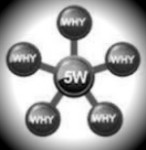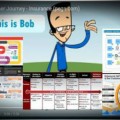Understanding everything you can about your customers is the key to identifying and answering their needs. This in turn is the key to successful products and services.
Traditional marketing research tools such as statistics, surveys and focus groups are still very pertinent. They will allow you to quantify your markets, give you a general knowledge and overview of certain aspects of your customers but they are not all that useful when trying to figure out their needs.
The two following tools will help you get the necessary data to kick start or refine the process of identifying your customers’ needs.
A day in the life
The name of this tool is self-explanatory. You achieve this mini-story by aggregating information from multiple sources. It can come from observing customers, interviewing them, having people who witnessed a day in the life of your target customers tell you what it’s like. Your own sales representatives and customer agents can be excellent sources of information for this as well.
The output can take the form of a written story, a recording or even a video with actors if the usefulness of the media outweighs the costs of production.
The output of this tool will give anyone who participates in the creation/renewal or optimising process of your product or service an invaluable insight into your customers’ thoughts, feelings, preoccupations, and daily reality. It will also contextualise any interaction your customer will have with your brand/product/company.
A day in the life is also a great tool to anticipate customer reaction and to spark new product ideas.
The five whys
This tool is simply the act of asking why after receiving an answer to an initial question five times. It allows you to do a deep dive into a statement. Although mostly used as a managing technique to understand the root causes of a problem it can also be applied to interviews with customers.
It is particularly useful to test out your assumptions or to get to the real customer needs as well as their motivations. The following example helps to understand the benefits of this tool. A public bus service assumes that their users’ primary need is for the buses to be on time.
WHY do you need the bus to be on time?
Because I need to get to work on time.
WHY do you need to get to work on time?
Well I don’t really have an exact time that I need to get to work by most days but I do want to know how much time it will take me to get there.
WHY do you need to know how much time it takes you to get to work?
I don’t need to know how many minutes it takes me, I just need to know that it won’t take me longer than I expect.
WHY do you need to know it won’t take you longer than you expect to get to work?
Because my time is precious.
WHY is your time precious?
My ‘’work time’’ is precious because I want to minimise it so I can have more leisure time.
If you are the company running the bus service you have just learnt that your target customer’s primary need is not to have the bus be on time but to minimise his commute time to get to work. Having your buses running according to schedule is only one of the components needed to satisfy this need. Other components would be making sure your customer has access to the times at which the bus will be at his stop and informing him of any service disruption on his route. Having an application available that could show him the best routes depending on traffic patterns of various times of the day would also contribute to satisfying his need. As would suggesting alternate modes of transportation (taxis, bicycle, walking) that would reduce his commuting time. The bus company got all this just by asking a simple question five times.
Obtaining ‘’horizontal’’ data on your markets such as socio-demographic information or how many potential customers a segment holds is useful to understand the financial potential of a market. ‘’Vertical’’ information such as the one obtained with A day in the life or the Five whys tools is useful to understand the needs, motivations and context of your customers. This type of knowledge is the one that will help you create successful products and services to extract all that you can from your potential market.











